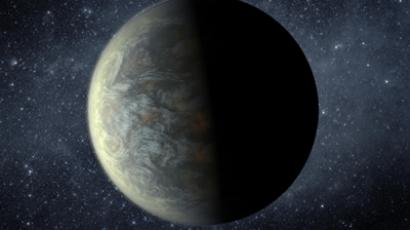Two Planets, Two Suns: NASA discovery could help find alien life

NASA’s Kepler space laboratory has discovered a pair of planets orbiting a pair of suns. The first-ever find could revolutionize knowledge of how planets are formed, and even identify alien worlds where life may flourish.
The Kepler-47 star system, about 5,000 light years away from Earth, has a bright sun and a pale sun that circle each other, and two planets bigger than the earth that rotate around their dance.Greg Laughlin, professor of astrophysics and planetary science at the University of California, said the discovery could turn our understanding of how planets appeared after the Big Bang on its head."This is an amazing discovery," he told SPACE.com "These planets are very difficult to form using the currently accepted paradigm, and I believe that theorists will be going back to the drawing board to try to improve our understanding of how planets are assembled."A planet with more than one sun, like Tatooine in Star Wars, was long imagined by artists, but the first such arrangement, known as a circumbinary system, was spotted less than twenty years ago.It was often assumed before that that a system of multiple planets would struggle to exist under the gravity of two stars at the same time, with planets either pulling away from the orbit or crashing into each other. Now, scientists are expecting to find more such systems.“If we get more data that confirms a third planet, then the sky’s the limit,” says Jerome Orosz from San Diego State University, who published the discovery of Kepler-47 in Science magazine.It is even possible such a planet will be detected in Kepler-47, he says. The Kepler space telescope was launched in 2009, with the hope of finding Earth-like planets in “habitable zones” that could potentially house life. It has found more than 2,300 potential alien worlds so far.The new discovery will make the search easier."Most of the stars in the galaxy are in binary or higher-order multiple systems, so the fact that planetary systems can exist in these types of systems is important. If we were restricted to looking for planets around single stars, we would be missing most of the stars in the galaxy," says Orosz.The planet closer to the suns circles them every fifty days, and is likely to be searing hot and unsuitable for life.But the further planet is in the “habitable range,” where water could exist. The body itself is likely a gas giant like Uranus, nonetheless researchers say its moons could be suitable for life.And even if it is not found there, there are billions more circumbinary systems in our galaxy alone."The thing I find most exciting is the potential for habitability in a circumbinary system," says Science study co-author William Welsh of San Diego State University.














